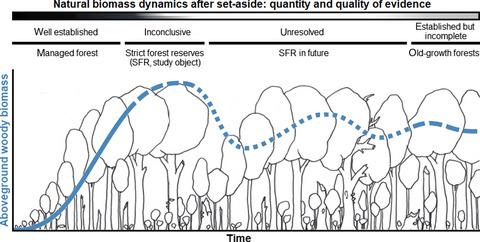Our official English website, www.x-mol.net, welcomes your feedback! (Note: you will need to create a separate account there.)
Limited sink but large storage: Biomass dynamics in naturally developing beech (Fagus sylvatica) and oak (Quercus robur, Quercus petraea) forests of north-western Germany
Journal of Ecology ( IF 5.5 ) Pub Date : 2021-07-04 , DOI: 10.1111/1365-2745.13740 Peter Meyer 1 , Rouven Nagel 1 , Eike Feldmann 1
中文翻译:

水槽有限但储存量大:德国西北部自然发育的山毛榉(Fagus sylvatica)和橡木(Quercus robur,Quercus petraea)森林的生物量动态
更新日期:2021-07-04
Journal of Ecology ( IF 5.5 ) Pub Date : 2021-07-04 , DOI: 10.1111/1365-2745.13740 Peter Meyer 1 , Rouven Nagel 1 , Eike Feldmann 1
Affiliation

|
- Currently, the dynamics underlying the storage and acquisition of biomass, and thus carbon, in naturally developing forests are under debate. A better understanding of the biomass dynamics of forests is needed to clarify the role played by naturally developing forests in the mitigation of climate change.
- Long-term monitoring data from unmanaged strict forest reserves (SFRs) in north-western Germany were used to analyse the biomass dynamics of pure beech, mixed beech and mixed oak forests. A complete balance of above-ground woody biomass (biomass) and growth, density-dependent and -independent mortality, as well as deadwood decay was derived. Density-independent mortality served as a proxy for disturbance severity.
- After a time since abandonment (TSA) of 50 years, the average biomass ranged between 334 t/ha in mixed oak and 478 t/ha in pure beech stands. The net change in biomass was positive in all forest types. Density-independent mortality and decay rates were much lower than the growth rates. Pure beech forests reached higher levels of biomass, a higher net change in biomass, and more growth than either of the mixed forest types. Biomass increased linearly with TSA in pure beech stands but followed an asymptotic course in the mixed forests. In the latter, the net change in biomass and growth were consistent with a unimodal development pattern. The development of biomass could not be explained by the ageing of the tree communities.
- Synthesis. We hypothesized that the observed biomass dynamics are a result of the interaction between resource supply within a limited growing space and the resource-use efficiency of the tree stand in conjunction with disturbances. The still-linear increase in the biomass of pure beech forests was assumed to reflect the high resource-use efficiency of beech, especially its use of light. The above-ground capacity of naturally developing broadleaved forests to store and acquire carbon is substantial. Accordingly, allowing broadleaved forests to develop naturally can contribute substantially to carbon storage and sequestration. However, our study also suggests that the above-ground carbon sink decreases after several decades.
中文翻译:

水槽有限但储存量大:德国西北部自然发育的山毛榉(Fagus sylvatica)和橡木(Quercus robur,Quercus petraea)森林的生物量动态
- 目前,在自然发展的森林中,生物质的储存和获取以及碳的储存和获取的动态正在辩论中。需要更好地了解森林的生物量动态,以阐明自然发展的森林在减缓气候变化中所起的作用。
- 来自德国西北部未管理的严格森林保护区 (SFR) 的长期监测数据用于分析纯山毛榉、混交山毛榉和混交橡木林的生物量动态。得到了地上木质生物量(生物量)和生长、密度相关和独立的死亡率以及枯木腐烂的完全平衡。与密度无关的死亡率作为干扰严重程度的代表。
- 在废弃 (TSA) 50 年之后,混合橡木林的平均生物量介于 334 吨/公顷和纯山毛榉林的 478 吨/公顷之间。所有森林类型的生物量净变化均为正值。与密度无关的死亡率和衰减率远低于增长率。纯山毛榉森林达到了更高的生物量水平,生物量的净变化更高,并且比任何一种混合森林类型的生长都更快。在纯山毛榉林中,生物量随 TSA 线性增加,但在混交林中遵循渐进过程。在后者中,生物量和生长的净变化与单峰发展模式一致。生物量的发展不能用树木群落的老化来解释。
- 合成。我们假设观察到的生物量动态是有限生长空间内的资源供应与林分的资源利用效率以及干扰相互作用的结果。假设纯山毛榉森林生物量的线性增长反映了山毛榉的高资源利用效率,尤其是其对光的利用。自然发展的阔叶林的地上储存和获取碳的能力是巨大的。因此,让阔叶林自然发展可以大大促进碳的储存和封存。然而,我们的研究还表明,地上碳汇在几十年后会减少。



























 京公网安备 11010802027423号
京公网安备 11010802027423号